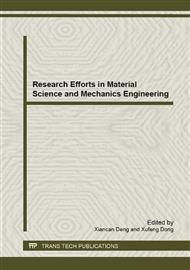[1]
K. E. Allan, C. E. Lenehan, D. A. Khodakov, et. al. High-performance capillary electrophoretic separation of double-stranded oligonucleotides using a poly- (ethylpyrrolidine methacrylate-co-methyl methacrylate)-coated capillary, ELECTROPHORESIS, 33(2012).
DOI: 10.1002/elps.201100514
Google Scholar
[2]
E. A. S. Doherty, C. W. Kan, B. M. Paegel, et. al. Sparsely Cross-Linked "Nanogel" Matrixes as Fluid, Mechanically Stabilized Polymer Networks for High-Throughput Microchannel DNA Sequencing, Anal. Chem., 76(2004)5249-5256.
DOI: 10.1021/ac049721x
Google Scholar
[3]
E. H. Turner, K. Lauterbach, H. R. Pugsley, et. al. Detection of green fluorescent protein in a single bacterium by capillary electrophoresis with laser-induced fluorescence, Anal Chem, 79(2007)778-781.
DOI: 10.1021/ac061778r
Google Scholar
[4]
A. Kotani, M. A. Witek, J. K. Osiri, H. Wang, et. al. EndoV/DNA ligase mutation scanning assay using microchip capillary electrophoresis and dual-color laser-induced fluorescence detection, Analytical Methods, 4(2012)58-64.
DOI: 10.1039/c1ay05366c
Google Scholar
[5]
G. W. Slater and H. L. Guo, An exactly solvable Ogston model of gel electrophoresis: I. The role of the symmetry and randomness of the gel structure, Electrophoresis, 17(1996) 977-988.
DOI: 10.1002/elps.1150170604
Google Scholar
[6]
Z. Shen, X. Liu, X. Zhou, et. al. Quantitative evaluation of the interaction between netropsin and double stranded oligodeoxynucleotides by microfabricated capillary array electrophoresis, J Sep Sci, 30(2007)1544-1548.
DOI: 10.1002/jssc.200600530
Google Scholar
[7]
M. C. Ruiz-Martinez, J. Berka, A. Belenkii, et. al. DNA sequencing by capillary electrophoresis with replaceable linear polyacrylamide and laser-induced fluorescence detection, Anal Chem, 65(1993)2851-2858.
DOI: 10.1021/ac00068a023
Google Scholar
[8]
T. Kaneta, T. Ogura, S. Yamato, and T. Imasaka, Band broadening of DNA fragments isolated by polyacrylamide gel electrophoresis in capillary electrophoresis, Journal of Separation Science, 35(2012) 431-435.
DOI: 10.1002/jssc.201100909
Google Scholar
[9]
P. D. B. H. Z. Oscar J. Lumpkin, Theory of gel electrophoresis of DNA, Biopolymers, 24(1985)1573-1593.
Google Scholar
[10]
J. R. J. N. C. T. M. L. Gary W. Slater, Quantitative analysis of the three regimes of DNA electrophoresis in agarose gels, Biopolymers, 27(1988)509-524.
DOI: 10.1002/bip.360270311
Google Scholar
[11]
J. N. Gary W. Slater, The biased reptation model of DNA gel electrophoresis: Mobility vs molecular size and gel concentration, Biopolymers, 28(1989)1781-1791.
DOI: 10.1002/bip.360281011
Google Scholar
[12]
J. A. Luckey and L. M. Smith, A model for the mobility of single-stranded DNA in capillary gel electrophoresis, Electrophoresis, 14(1993) 492-501.
DOI: 10.1002/elps.1150140176
Google Scholar


